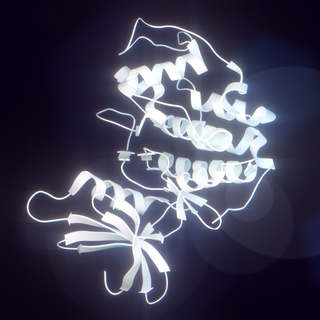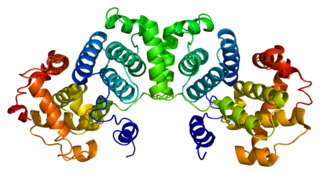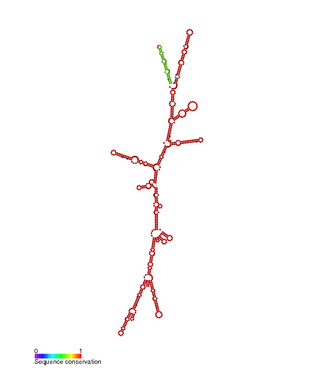Related Research Articles
Genotoxicity is the property of chemical agents that damage the genetic information within a cell causing mutations, which may lead to cancer. While genotoxicity is often confused with mutagenicity, all mutagens are genotoxic, but some genotoxic substances are not mutagenic. The alteration can have direct or indirect effects on the DNA: the induction of mutations, mistimed event activation, and direct DNA damage leading to mutations. The permanent, heritable changes can affect either somatic cells of the organism or germ cells to be passed on to future generations. Cells prevent expression of the genotoxic mutation by either DNA repair or apoptosis; however, the damage may not always be fixed leading to mutagenesis.
Immediate early genes (IEGs) are genes which are activated transiently and rapidly in response to a wide variety of cellular stimuli. They represent a standing response mechanism that is activated at the transcription level in the first round of response to stimuli, before any new proteins are synthesized. IEGs are distinct from "late response" genes, which can only be activated later, following the synthesis of early response gene products. Thus IEGs have been called the "gateway to the genomic response". The term can describe viral regulatory proteins that are synthesized following viral infection of a host cell, or cellular proteins that are made immediately following stimulation of a resting cell by extracellular signals.

Proliferating cell nuclear antigen (PCNA) is a DNA clamp that acts as a processivity factor for DNA polymerase δ in eukaryotic cells and is essential for replication. PCNA is a homotrimer and achieves its processivity by encircling the DNA, where it acts as a scaffold to recruit proteins involved in DNA replication, DNA repair, chromatin remodeling and epigenetics.

p21Cip1, also known as cyclin-dependent kinase inhibitor 1 or CDK-interacting protein 1, is a cyclin-dependent kinase inhibitor (CKI) that is capable of inhibiting all cyclin/CDK complexes, though is primarily associated with inhibition of CDK2. p21 represents a major target of p53 activity and thus is associated with linking DNA damage to cell cycle arrest. This protein is encoded by the CDKN1A gene located on chromosome 6 (6p21.2) in humans.

Cyclin-dependent kinase 1 also known as CDK1 or cell division cycle protein 2 homolog is a highly conserved protein that functions as a serine/threonine protein kinase, and is a key player in cell cycle regulation. It has been highly studied in the budding yeast S. cerevisiae, and the fission yeast S. pombe, where it is encoded by genes cdc28 and cdc2, respectively. With its cyclin partners, Cdk1 forms complexes that phosphorylate a variety of target substrates ; phosphorylation of these proteins leads to cell cycle progression.

G2/mitotic-specific cyclin-B1 is a protein that in humans is encoded by the CCNB1 gene.

Cyclic AMP-dependent transcription factor ATF-3 is a protein that, in humans, is encoded by the ATF3 gene.

Cell cycle checkpoint protein RAD17 is a protein that in humans is encoded by the RAD17 gene.

DNA polymerase beta, also known as POLB, is an enzyme present in eukaryotes. In humans, it is encoded by the POLB gene.

DNA damage-inducible transcript 3, also known as C/EBP homologous protein (CHOP), is a pro-apoptotic transcription factor that is encoded by the DDIT3 gene. It is a member of the CCAAT/enhancer-binding protein (C/EBP) family of DNA-binding transcription factors. The protein functions as a dominant-negative inhibitor by forming heterodimers with other C/EBP members, preventing their DNA binding activity. The protein is implicated in adipogenesis and erythropoiesis and has an important role in the cell's stress response.

Growth arrest and DNA-damage-inducible protein GADD45 alpha is a protein that in humans is encoded by the GADD45A gene.

Polo-like kinase 3 (Drosophila), also known as PLK3, is an enzyme which in humans is encoded by the PLK3 gene.

Growth arrest and DNA-damage-inducible, beta, also known as GADD45B, is a protein which in humans is encoded by the GADD45B gene.

Protein phosphatase 1 regulatory subunit 15A also known as growth arrest and DNA damage-inducible protein GADD34 is a protein that in humans is encoded by the PPP1R15A gene.

Growth arrest and DNA-damage-inducible protein GADD45 gamma is a protein that in humans is encoded by the GADD45G gene on chromosome 9. GADD45G is also known as CR6, DDIT2, GRP17, OIG37, and GADD45gamma. GADD45G is involved in several different processes, including sexual development, human-specific brain development, tumor suppression, and the cellular stress response. GADD45G interacts with several other proteins that are involved in DNA repair, cell cycle control, apoptosis, and senescence. Low expression of GADD45G has been associated with many types of cancer.

Mitogen-activated protein kinase kinase kinase 4 is an enzyme that in humans is encoded by the MAP3K4 gene.

Growth arrest and DNA-damage-inducible proteins-interacting protein 1 is a protein that in humans is encoded by the GADD45GIP1 gene.

8-Oxo-2'-deoxyguanosine (8-oxo-dG) is an oxidized derivative of deoxyguanosine. 8-Oxo-dG is one of the major products of DNA oxidation. Concentrations of 8-oxo-dG within a cell are a measurement of oxidative stress.

gadd7 is a non-coding RNA discovered in the ovaries of the chinese hamster. Homologs have been identified in the closely related Long-tailed Dwarf Hamster. Although the gene for this RNA contains open reading frames, translation studies found no protein product hence gadd7 has been classified as non-coding RNA.
Albert J. Fornace Jr. is a professor in the departments of Oncology, Biochemistry and Molecular & Cellular Biology, and Radiation Medicine at Georgetown University. He has also been awarded the Molecular Cancer Research Chair at Lombardi Comprehensive Cancer Center, joining Georgetown in 2006 from the Harvard School of Public Health. Earlier, he was chief of the Gene Response Section at the National Cancer Institute. He graduated from La Salle College High School in Philadelphia, Pennsylvania (1967), and received his B.S. (1970) and M.D. (1972) from the Jefferson-Penn State joint pre-medical/medical program.
References
- ↑ Fornace, A.J.; Jackman, J.; Hollander, M.C.; Hoffman-Liebermann, B.; Liebermann, D.A. (1992). "Genotoxic-stress-response genes and growth-arrest genes: gadd, MyD, and other genes induced by treatments eliciting growth arrest". Annals of the New York Academy of Sciences. 663: 139–53. doi:10.1111/j.1749-6632.1992.tb38657.x. PMID 1482047. S2CID 37885339.
- ↑ Liebermann, D.A.; Hoffman, B. (2002). "Myeloid differentiation (MyD)/growth arrest DNA damage (GADD) genes in tumor suppression, immunity and inflammation". Leukemia. 16 (4): 527–41. doi: 10.1038/sj.leu.2402477 . PMID 11960329.
- ↑ Schüle KM, Leichsenring M, Andreani T, Vastolo V, Mallick M, Musheev MU, Karaulanov E, Niehrs C. GADD45 promotes locus-specific DNA demethylation and 2C cycling in embryonic stem cells. Genes Dev. 2019 Jul 1;33(13-14):782-798. doi: 10.1101/gad.325696.119. Epub 2019 Jun 6. PMID 31171699
- ↑ Plyusnina EN, Shaposhnikov MV, Moskalev AA. Increase of Drosophila melanogaster lifespan due to D-GADD45 overexpression in the nervous system. Biogerontology. 2011 Jun;12(3):211-26. doi: 10.1007/s10522-010-9311-6. Epub 2010 Dec 9. PMID 21153055
- ↑ Fornace, A.J.; Alamo, I.; Hollander, M.C. (1988). "DNA damage-inducible transcripts in mammalian cells". Proceedings of the National Academy of Sciences. 85 (23): 8800–4. Bibcode:1988PNAS...85.8800F. doi: 10.1073/pnas.85.23.8800 . PMC 282594 . PMID 3194391.
- ↑ Abdollahi, A.; Lord, K.A.; Hoffman-Liebermann, B.; Liebermann, D.A. (1991). "Sequence and expression of a cDNA encoding MyD118: a novel myeloid differentiation primary response gene induced by multiple cytokines". Oncogene. 6 (1): 165–7. PMID 1899477.
- ↑ Zhang, W.; Bae, I.; Krishnaraju, K.; Azam, Naiyer; et al. (1999). "CR6: A third member in the MyD118 and Gadd45 gene family which functions in negative growth control". Oncogene. 18 (35): 4899–907. doi: 10.1038/sj.onc.1202885 . PMID 10490824.
- ↑ Beadling, C.; Johnson, K.W.; Smith, K.A. (1993). "Isolation of interleukin 2-induced immediate-early genes". Proceedings of the National Academy of Sciences. 90 (7): 2719–23. Bibcode:1993PNAS...90.2719B. doi: 10.1073/pnas.90.7.2719 . PMC 46167 . PMID 7681987.